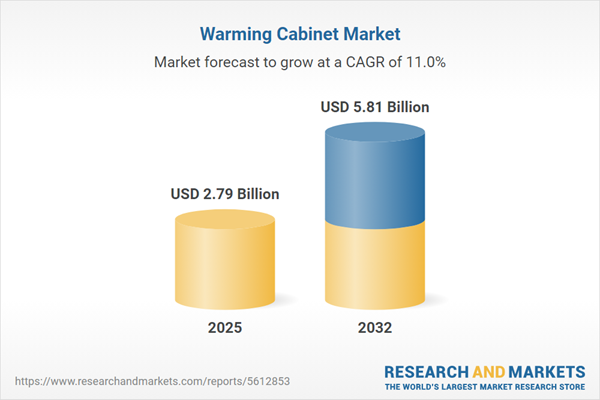Speak directly to the analyst to clarify any post sales queries you may have.
Warming cabinets have become indispensable for organizations striving to improve operational efficiency, maintain precise temperature control, and ensure compliance across foodservice, laboratory, and healthcare environments. Senior leaders evaluating warming solutions need clarity on market drivers, technological advances, and strategic considerations critical for long-term value.
Market Snapshot: Warming Cabinet Market Growth & Opportunities
The warming cabinet market grew from USD 2.52 billion in 2024 to USD 2.79 billion in 2025, and is expected to maintain momentum through 2032, propelled by a CAGR of 11.00%, reaching USD 5.81 billion. This robust expansion reflects heightened investment in foodservice consistency, regulatory compliance, and digital transformation across major application sectors. As organizations continue to prioritize safety and workflow assurance, the warming cabinet market stands out for its adaptability and integration potential.
Scope & Segmentation of the Global Warming Cabinet Market
This report provides an in-depth assessment of the warming cabinet market with a focus on strategic segmentation, covering product types, technologies, end users, distribution channels, and regional markets.
- Product Types: Electrical (single-phase and three-phase options, including high-power and standard models), gas (natural gas, propane), and hybrid systems for versatile fuel choice.
- Heating Technologies: Convection and steam-based mechanisms that support precise temperature adherence and heat recovery rates.
- End Users: Commercial kitchens (covering catering services and restaurants), hospitality (hotels and resorts), hospitals and healthcare facilities (including clinics and hospitals), and laboratories (pharmaceutical labs, research institutes).
- Distribution Channels: Direct sales, partnerships with national and regional distributors, and online channels such as e-commerce platforms and manufacturer websites.
- Regions Covered: Americas (United States, Canada, Mexico, Brazil, Argentina, Chile, Colombia, Peru), Europe (including UK, Germany, France, and others), Middle East (UAE, Saudi Arabia, Qatar, Turkey, Israel), Africa (South Africa, Nigeria, Egypt, Kenya), and Asia-Pacific (China, India, Japan, Australia, South Korea, Indonesia, Thailand, Malaysia, Singapore, Taiwan).
Key Takeaways: Strategic Insights for Senior Stakeholders
- Warming cabinets are integral for maintaining quality, traceability, and safety where temperature-sensitive materials or food products are handled.
- Manufacturers increasingly differentiate through features such as user-friendly interfaces, energy optimization, and IoT connectivity aligned with broader digital transformation trends.
- Modular architecture and scalable designs prove crucial for organizations seeking flexible system upgrades and cost-effective lifecycle management.
- Sustainability and regulatory requirements are shaping procurement, compelling firms to consider energy efficiency, compliance certifications, and lifecycle impacts as core purchasing drivers.
- Regional differences in regulations, infrastructure, and market maturity demand locally tailored deployment and go-to-market strategies to maximize adoption and return on investment.
- Collaborative development processes and robust service ecosystems set leading suppliers apart by responding directly to evolving operational challenges and end user needs.
Tariff Impact: Navigating U.S. Policy and Supply Chain Dynamics
Recent U.S. tariffs on materials such as steel, aluminum, and electronic components have increased production costs and prompted stakeholders to rethink sourcing and inventory strategies. Manufacturers are adjusting by diversifying suppliers, negotiating long-term contracts, and exploring tariff-exempt assembly zones. Effective communication with buyers and agile supply chain management have become essential for maintaining resilience and competitiveness as the policy landscape continues to evolve.
Methodology & Data Sources
The report combines primary research through interviews and surveys with industry experts, alongside a comprehensive review of regulatory texts, technical documentation, and trade reports. Analytical models—including scenario analysis and cost benchmarking—were employed, and findings were validated by an expert advisory panel to ensure relevance and accuracy.
Why This Report Matters
- Enables strategic planning by illuminating technology trends and regulatory influences shaping procurement strategies in the warming cabinet market.
- Equips C-level executives and procurement leaders with actionable insights to optimize investment, manage risk, and support compliance.
- Supports competitive positioning by profiling leading players, collaboration strategies, and new business models emerging in the sector.
Conclusion
Organizations evaluating warming cabinet investments benefit from a thorough understanding of technology advancements, regional dynamics, and compliance imperatives. This report delivers strategic intelligence to help navigate market complexity and drive informed decision-making for sustainable operational leadership.
Additional Product Information:
- Purchase of this report includes 1 year online access with quarterly updates.
- This report can be updated on request. Please contact our Customer Experience team using the Ask a Question widget on our website.
Table of Contents
3. Executive Summary
4. Market Overview
7. Cumulative Impact of Artificial Intelligence 2025
Companies Mentioned
The companies profiled in this Warming Cabinet market report include:- Alto-Shaam, Inc.
- Hatco Corporation
- APW Wyott Manufacturing Company
- Illinois Tool Works Inc.
- Cambro Manufacturing Company
- Metro, Inc.
- True Manufacturing Co., Inc.
- The Vollrath Company, L.L.C.
- Nemco Food Equipment, L.L.C.
- Cres Cor LLC
Table Information
| Report Attribute | Details |
|---|---|
| No. of Pages | 189 |
| Published | November 2025 |
| Forecast Period | 2025 - 2032 |
| Estimated Market Value ( USD | $ 2.79 Billion |
| Forecasted Market Value ( USD | $ 5.81 Billion |
| Compound Annual Growth Rate | 11.0% |
| Regions Covered | Global |
| No. of Companies Mentioned | 11 |









